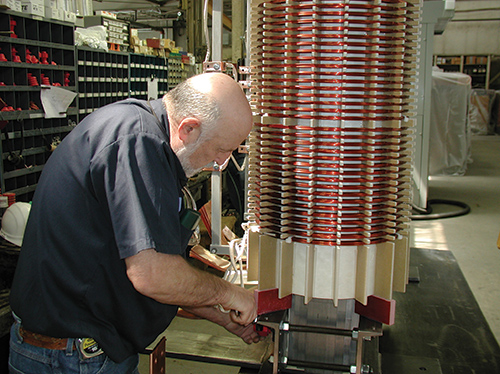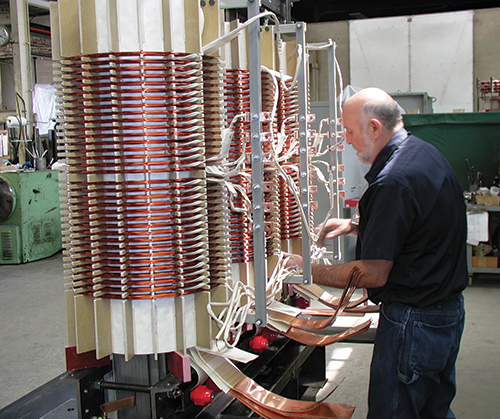How much can you afford to lose? For any CEO or manager in charge of a plant that purchases electricity in bulk, that question must be faced when considering the replacement of a power transformer. If one goes down, the loss of operational capability is always crippling. The process gets interrupted, the assembly line halts, and information transfer stops in its tracks.
Transformers seldom go down, but when they do the effects to the bottom line are immediate and devastating. Beyond the lost income from the sudden stoppage of the production run, the risk of subsequent fires, fines, security lapses and lawsuits can quadruple the damages. The effects ripple throughout the organization. Managers get fired and, if the outage lasts long enough, stockholders get angry.
Utilizing a two-pronged approach, though, facility managers can stack the odds in their favor and prevent the loss of hundreds-of-thousands of dollars. Prevention prevails through the selection of quality transformers in the first place. Secondly, quick replacement with an exact match can keep losses to a minimum.
Identifying a robust transformer
A basic knowledge of the design, construction and materials of power transformers provides facility managers – as well as those who sign the purchase order for such big-ticket items – with the ability to maximize the return on investment on what is arguably the heart of any industrial plant. More importantly, it can help prevent disastrous emergencies from taking place at all.
Starting from the top, power transformers are required to step-down the higher voltages delivered by the electric utility company. Common types of transformers found in industrial plants include liquid-filled (so called because they use oil, or similar, for cooling purposes), and dry type transformers. Given that dry types are air-cooled, they pose less chance of leakage and fire risk.
“Whether oil-filled or dry, the design, construction and materials used make a huge difference in terms of transformer reliability,” says Alan Ober, vice president of Engineering and Manufacturing for Electric Service Company. Founded in 1912 by former Westinghouse engineers, the firm specializes in providing quality new, repaired, and rebuilt transformers – under emergency conditions when necessary – from their manufacturing plant.

Dry type transformer for emergency replacement - designed to duplicate ‘form, fit and function’ as closely as possible
According to Ober, the way the coils are wound around the core of the transformer greatly affects its robustness. Because of increased axial forces acting at the corners of rectangular wound transformers, energy gets wasted and noise is created. On the other hand, voltage stresses are halved between the discs of comb-wound designs. Hence, round-wound transformers stay cooler, run quieter, and present less risk of short circuit.
Beyond the improved reliability factor, the increased efficiency of the round design saves costs in real time, as the plant consumes less electricity. Some wound round transformers even exceed the proposed efficiency standards for Energy Star compliance, drastically lowering utility costs for a plant, according to Ober.
What to do when the power goes out
Any plant or facility that’s been in operation for a while is subject to a sudden loss of power since many transformer failures stem from the fact that so many older models are still in place.
“The transformers that failed at our plant were 37 years old – definitely at their end-of-life cycle,” recalls Jonathon Peper, senior engineer at PacifiCorp’s Wyodak Plant in Gillette, WY. PacifiCorp delivers electricity to more than 724,000 homes and businesses in the Northwest through 74 generating plants, 61,500 miles of electric distribution line, and 15,800 miles of transmission line. “Faults, like voltage transients, that they were able to handle when new, are just the final last hurrah. Shorts occur because over the years heat and moisture degrade the insulation, especially paper.”
Peper describes how in July of 2013 they lost a 1.5 MVA transformer that fed a critical piece of equipment. As a result of the fault, the entire plant went down.
“When that happens, we have to purchase electricity from elsewhere at spot market prices,” Peper explains. “That downtime can cost us anywhere from $300,000 to $700,000 per day depending on variations in load peaks, day of the week, and weather.”
To rapidly stem such losses, transformer companies exist that specialize in emergency replacement. For mission critical applications, transformers can be prepped for shipping within a matter of hours. But to ensure a rapid return to operation, any replacement transformer must duplicate ‘form, fit and function’ as much as possible.
“The biggest challenge we face is fitting the transformer in the enclosure and getting the existing switch gear to line-up,” says Tom Arnold, a project manager with one of the nation’s leading electrical contractors. “You can’t change the cabinet because there’s other gear on each side of it, so a full day can be wasted while we have to rework all the bussings.”
Attention to details like duplication of the high and low voltage bussbars can spell the difference between a lengthy and costly replacement process versus a quick, cost-effective plug-and-play solution.

Transformer assembly requires highest level of duplication
“The guys at ELSCO come out and do field measurements, and then they go back to the shop and build it so that we can avoid such issues,” Arnold continues. “We’ve put in 13-14 of their transformers and they line right up so it makes the job go a lot quicker. For instance, we did one rush job for a national airfreight company that suddenly lost its transformer. They ordered a rental unit from ELSCO and they got it here in a couple of hours. We then put it in and got them going again so they could still run freight that very same day.”
Similar replacement success took place at the Pacific Power plant.
“We got hold of ELSCO and they came back with a design that met the exact specification I was after,” says Peper. “They delivered a transformer that fit in the existing location without us needing to modify the enclosure or move the switchgear and the high side disconnect switch. We ended up buying a total of five dry type transformers from them. In every case we got a great design.”
Saving more money by remanufacturing
In cases where no exact replacement units are immediately available, many companies offer similar units for rent while the original plant transformer is remanufactured. This keeps plants fully operational until the original transformer – in like-new condition – can be placed back on the pad.
Similar considerations apply when purchasing a reconditioned transformer as for a new one; except that the expertise of the remanufacturer plays a greater role.
“At the bottom end of the remanufacturing scale are transformers that are brought in, fixed up just enough to be operational, superficially cleaned and then sent out the door,” notes Ober. “These won’t hold up as well as transformers that are completely refurbished, and could leave your plant vulnerable once again.”
A more completely remanufactured transformer provides far greater security against failures. There should be a complete rewinding of the primary and secondary coils along with brand new high and low voltage bussbars. While the original core can be kept 90 percent of the time, even it must be replaced occasionally as older steel is less energy efficient than modern core materials.
Attention to detail pays dividends in the remanufacturing process. Hand winding ensures the highest quality. Additionally, the deburring of the copper conductor helps ensure that the insulation won’t be punctured and create a short circuit.
Ultimately, any remanufactured transformer must meet or exceed all NEMA, ANSI and IEEE standards.
About the Author
David Rizzo is a Torrance, California-based author. He has penned three trade books, 200 technical articles and 500 newspaper columns. Rizzo covers a wide range of topics, specializing in technology, medicine and transportation.







